Cart - 0 Item
You have no items in your shopping cart.
| SVS, 4x4 SVS, Mag, Magtrax, Ultra Mag, Mag ForceV, Mag ForceZ, IVCB, Flying Arm, Pitch Centrifugal, Infiniti Brake, DC, Inifity Brake, SVS Infinity, Knobb and what's the next?
Right: Shimano Bantam Mag Cast Revised Feb. 2018 |
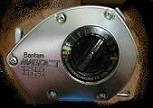 |
The most advanced brake systems
Recent high-performing casting reels are equipped with "innovative" brake systems, but manufacturer doesn't tell us the details. This topic is about brake systems, from the scientific point of view, to help you understand the difference of those NEW brake systems.
Why and where do we need brakes?
Brakes of casting reels has two major objectives, 1) to adjust the initial spool speed and the initial rig flying speed just after casting, and 2) to control the decelerate rate of spool.
1. Initial Brake
Imagine the instant when you swing a rod and you release the finger on spool. The accelerated rig is just pulling lines to spin the spool. Because of the recoil from spool inertia and law of phisics, rig flying speed will be reduced, and always get slower than spool spin. This is why initial brake should be applied, or spool will have a huge backlash. The extent of brake needed relative large, and it is mostly determined by the balance of spool weight and rig weight. To prevent backlash effectively, brake has to have wide range adjustability at high-speed.
2. Decelerate Brake
During casting, flying rigs receive air dragging to reduce speed, and spool needs to brake or it will over-run to make backlash. When rig is heavy, small and in shapes like rocket, it receives little dragging to reduce speed, shown as EASY on the left chart below by blue line. After it reaches to the maximum speed, it decelerate slowly. On the other hand, line in red shows the casting with high deceleration, like casting bulky, weired shaped light rig like Rapara Balsa Shad-Rap against winds. Rig has the same initial flying speed, but need more brake thereafter, or spool will over-run. To prevent backlash effectively, brake has to have wide range adjustability at middle to slow-speed.
Adding to those two situations, pitching and flip casting needs a different brake profile, very low brake in the tactics. Rigs doesn't have speed to pull line enough, and slightest brake may damage the easiness in pitching.
Now we learned the necessity of spool brake, and let's look into brake systems in market.
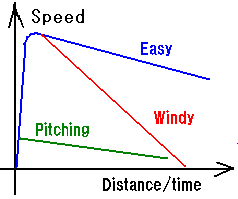 |
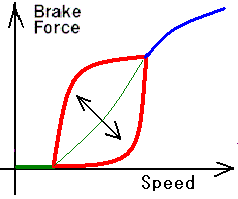 |
Basic brake systems
There are two major brake systems, centrifugal and magnet systems. These two systems will continue to dominate the reel brake systems because they are easy to manufacture, and reliable. Followings are brief explanation of these two, and the third brake, cast control cap.
Centrifugal system utilizes the friction of brake blocks pressed inside of brake ring. The brake force is proportional to the square of spool speed. Therefore, when the spool speed is fast, brake force is much larger than when spin speed is slow. You might have noticed that centrifugal reels cast well even with slow casting speed, like pitching, and you feel that lure flies at the end of casting. This is because of the basic exponential shape and ineffective brake range near speed 0. However, you might also have noticed that even if you try harder, casting range doesn't change much. This is because the exponential brake force at higher speed strongly regulates the initial speed.
SVS system (Shimano) lets you change the brake profile proportional to the number of brake blocks activated manually. 4x4 SVS (Scorpion 1000) is the system which allow you to change the number by dial. Both system allows us to change the brake profile up and down.
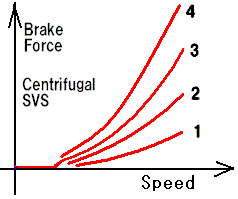 |

Centrifugal brakes are less effective at slower than some speed because brake blocks to slip on oil at the surface of brake rings. This character is described as the flat brake force at the beginning. Lines indicate the brake force, if 1, 2, 3 or 4 brake blocks are activated respectively. |
Magnet brake system utilizes the electromagnetic force, which occurs between magnets and moving metal close by, in this case the spool wall for reels. The brake force is almost directly proportional to the spool speed. The brake force is inversely proportional to the distance between magnets and spool. And the magnet brake system was the first brake system to be able to adjust the force from outside, by changing the distance between magnet and spool wall by dial. It may have wide adjusting range, but has much larger brake at slow speed than centrifugal systems. The brake at high speed is less than centrifugal system, and magnet brake allows higher initial speed.
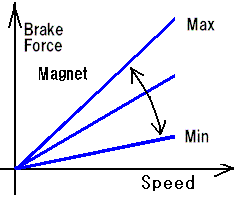 |
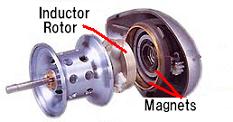 |
| The conventional magnet brake systems were composed of a brake panel with 3-5 small magnets sitting close to spool. Recent magnet systems use inductor rotors for more fine adjustability. Dial changes the strength of magnetic field between two C shaped magnets, where induct rotor moves. |
Because of great adjustability, and relatively high brake force at slow speed, magnet systems are quite good for casting with high deceleration rate, like casting against winds.
Casting control cap, or mechanical brake works to change the initial brake load, and have almost stable brake force regardless of speed. The stable brake force will be added, and it pushes up the profiles of brakes upwards. The brake force is relatively smaller than other system, but effective at close to speed 0 where other systems don't conduct enough brake force. In skipping, rig decelerates brutally after it hits water, and the casting control knob is the only effective brake at the situation. Tight up the cap.
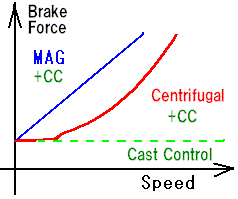 |
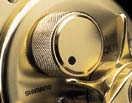
Above is the cast control cap of Conquest 100. It clicks finely, and will not get loose while fishing. |
Advanced Brake systems. What's available today?
In the category of centrifugal brakes, SVS and the 4x4 SVS of Shimano are advanced to have some extent of adjustability as explained above. ABU also released 6 points brake models. Now we have more combined, innovative, adjustable brake systems and let's look into them.
Pitch Centrifugal brake on ABU Revo is quite specific brake system addressing slow speed brake. Its brake blocks have small springs inside preventing from contacting to brake ring lower at some spool speed. This system allows the spool to have no brake force until it exceeds the set speed. As the system name indicates, it is for pitching, in which casting speed is quite low. (April, 2012)
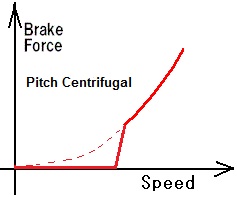 |
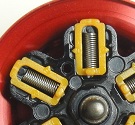
Yellow centrifugal blocks are held back by springs. |
Automag, trial to change brake profile automatically. After the first magnet brake has been invented, several interesting modifications have been invented related to the magnet brakes. One innovation to change the brake profile was ABU's Automag brake system equipped to Ultra Mag, XLT-FL, 1021FL around 1982-1986. It achieved the saturating brake at high speed by letting brake panel move away from spool to maximize initial spool speed. The panel holding magnets were suspended by springs, and as the panel receive the brake force from spool, it slides through a guide and moves away. The adjusting dial is to set the spring tension and change the brake-saturating point.(see left picture below) The system doesn't change the brake profile at slower than the set speed.
 |
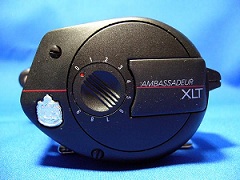 |
| revised Dec 2011 | ABU Ambassadeur XLT-FL |
Combination of brake systems was another trial. ABU's S3000C/T3000C (Promax) were equipped with both centrifugal and magnet brakes. By changing magnet brake dial, we could control the magnet brake force. It turned out at high speed, brake is dominated by centrifugal profile, and at middle-slow speed it is dominated by magnet system. Even though S3000C had 0 magnet force on dial, its brake at slow speed was too much for pitching. (revised Nov. 2011)
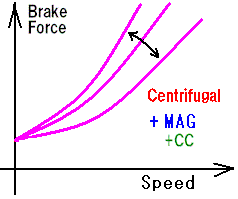 |
It is said the combination system is patented by Daiwa, and ABU doesn't install brake blocks to its combination brake models, but only includes the blocks to packages. |
Infiniti Brake on ABU Revo is another trial, the combination of magnet brake and pitch centrifugal. And the good of IB system is that you may switch off either magnet or centrifugal system, or both. The advantage of carrying both brake system on one reel is significant. (April, 2012)

Mag Force V and Mag Force Z (Daiwa) is the first and only brake system to have the profile proportional to the cube of spool speed. It is advanced magnet brake system combined with centrifugal position control system. Before it reaches at speed S1, the rotor does not move and the system conduct little brake. At the speed between S1 and S2, the inductor rotor held by centrifugal brackets moves in and out of magnets, depending on the speed of the spool. After it reaches at S2, the rotor does not move any more, and it has the magnet brake profile, directly proportional to the speed.
MagForce V/Z system enabled us to change the centrifugal-like brake profiles finely and widely. Adding to this, because of its steeper profiles than centrifugal brakes, it cast very well with slow speed.
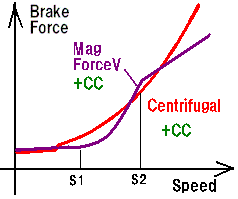 |
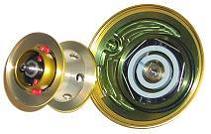
The red parts pushes out the gold inductor rotor between magnets. (shown in gray) (Green/Gold Millionaire CV-Z.) |
What is innovational to the Mag ForceV/Z is the fact that it addresses the requirement at slow speed by changing the brake profile. By inserting cubic profile in the middle of magnet brake profile, it maintains the advantage of magnet brake at high speed, and achieves the little brake at slow speed and relatively wide range of adjustability at the middle speed. (revised April 2009)
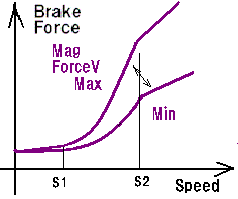 |
This is shown by the left picture. As you max the dial, you'll have more brake at middle, but brake at high speed is still on the line of magnet profile, not exponential. Even with max, the brake at slow speed is minimal and you may pitch easily. And, if you choose the min, it will conduct little brake at middle speed, which enable long flying casting.
One disadvantage of the Mag Force V, Z is that it requires relatively high spool speed to conduct steady brake force from cast to cast. Because the profile between S1 and S2 is set by the movement of brake rotor, it seems the conducted brake force is a little hard to expect especially at middle spool speed. |
Air Brake system (Daiwa 2014) is looking quite similar to Magforce Z system, but the inductor rotor will be pushed out by the brake force itself. Inductor rotor is set on a cam to spool and spring held back. Rotor will pop out when spool speed exceed set speed. And the popped out rotor will get more force from brake and it may not stay at the middle of movement. Interestingly, the rotor will get back at far slower speed than it popped out, to my understanding, making it asymetry brake profile to spool speed.
I need to figure this out more clearly, and let me have more time. Feb 2, 2018
Flying Arm (Ryobi 1998), IVCB (ABU Morrum SX 2004), SVS Infinity (Shimano 2014) are advanced centrifugal brake system, which can be adjusted from outside with non-step, continuously. They utilize the centrifugal forces of leverage arms connected to the spool. (black arm in the picture below) The brake profiles are the same as conventional centrifugal brakes, and you may adjust.
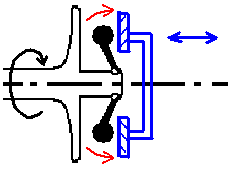 |
As spool rotates, the black leverage arms (brake block) will receive centrifugal force and pushes the blue brake panel attached to the reel body. By changing the position of brake panel, the pushing force will change. When the angle of brake shoe is 45 degree, it has the max brake, and at zero degree it has no brake. Because the brake shoes are small, the brake panel should be placed accurately square to the spool shaft pane to make the system effective. It requires very precise design and manufacturing technologies. And, it needs to be well designed otherwise it could happen that 7 out of 15 dial settings are useless that they have too little brake, which happened to Morrum. |
NOBBY system, Magnet brake with instantly adjustable knob is currently the best brake system to achieve the longest casting distance in tournament casting competition. Where casters use non-level wind reels to cast around 100g sinkers to 250-300yds!! The trick of Nobby is that in the beginning of casting, it is a normal magnet brake system, but you may reduce the brake in the later manually. You will turn the knob to reduce the brake, while watching the line column. As you may easily notice, this is not for fishing, but gives us a great insight in brake system. Asymmetry brake profile for spool speeds in up and down is the key for longer casting without birds nest. (Sep. 2011)
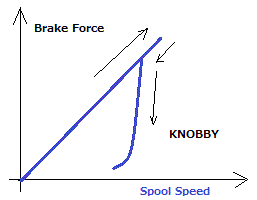 |
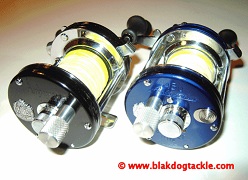 photo borrowed from blakdogtackle.com photo borrowed from blakdogtackle.com |
DC, digital controlled brake of Shimano is said to allow us to cast 5.8oz rigs 70m easily, effectively preventing birds nest without thumbing. WOW. It senses the spool speed at a very high frequency, and conduct appropriate brake force based on the brake mode selected. I assume asymmetry brake profile is programmed to achieve both long cast and non-birds nest. Because I may not read the programs installed, I have nothing more to tell about this system. Sorry. (April 2009)
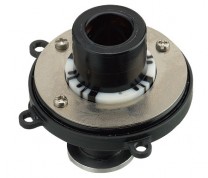 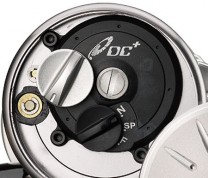 |
|
Conclusion
I used to conclude Mag Force V and Z system of Daiwa is the most advanced brake system currently available for fishing reels. What makes it the most advanced is the ability to address the requirements at all speed ranges, and relatively wide adjusting range at middle speed, without using computer. The Flying Arm, IVCB comes to the second, a little a head of 4x4 SVS, because of continuous adjusting range. Shimano's SVS, Conventional magnet, Combination of magnet and centrifugal will come next. Although SVS is very refined system, troubles of changing setting is a large drawbacks. If you don't cast against wind, SVS will come close to 4x4 SVS though. This conclusion doesn't immediately mean that the reel with Mag Force V is the best fishing reel. Performances of casting reels are affected by more factors, like inertia of spool, smoothness of ball bearings, stiffness of frame, weight and etc. I admit Shimano's SVS casts very well in normal conditions, and I love it. Hope this help you understand the differences of brake systems and find the best performing reel to you.
| Speed: | Slow: | Middle: | High: | Comment |
| Requirements | little brake | widely adjusting | less brake | |
| Objectives of requirements | Free fly for pitching, flip casting | Prevent birds nest, but allow long casting | high initial casting speed | |
| Centrifugal | Great | Bad (Non-adjustable) | Fair | |
| SVS | Great | Good* | Fair* | Middle and high doesn't co-exist |
| 4x4 SVS | Great | Good* | Fair* | Middle and high doesn't co-exist |
| Pitch Centrifugal | Greatest | Good* | Fair* | The only system addresses slow speed |
| Conventional magnet | Bad | Great | Good | |
| Auto Mag | Bad | Great | Great* | The only system addresses high speed |
| Combo Centri+Mag | Bad | Great | Fair* | Centrifugal adds more brake at high speed. |
| Infiniti Brake | Great | Great | Good | You may choose one from a lot of finely-adjusted brake profiles |
| Mag Force V / Z | Great | Great | Good | Simple, but well designed |
| Flying Arm, IVCB | Great | Good* | Fair* | Middle and high doesn't co-exist |
| Knobby | - | Great | Great | Manual adjusting is not practical, but achieves the longest casting distance |
Read more interesting Tackle Topics
Go back to JapanTackle Home and see more interesting products

